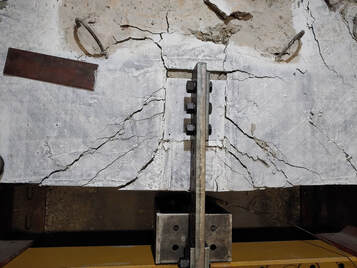MY SITE
Many structures are built using both reinforced concrete and structural steel. How can we better understand the interface between the two and make the design process easier?
Projects associated with the Steel Centre at the University of Alberta https://www.steelcentre.ca/.
Projects associated with the Steel Centre at the University of Alberta https://www.steelcentre.ca/.
Standardization of Embedded Plates for Steel Concrete Connections
|
Lead: Ian Chin
Thesis: era.library.ualberta.ca/items/ed642cd8-e58f-4320-a6bc-aac7f7cc8d0e Embedded plates are commonly used to connect structural steel members to reinforced concrete building elements such as walls and columns. Due to a lack of readily available industry-wide standard embedded plate designs, embedded plates are often custom designed for each project. This leads to many inefficiencies in the design, fabrication, and installation of these plates. Additionally, the current Canadian design standard for concrete requires many assumptions when evaluating embedded plate capacity, leading to inconsistency among designers. This research project aims to improve the efficiency of the embedded plate construction process by proposing standard embedded plates, and then testing selected embedded plates to verify the predicted capacities and key design assumptions. Three standard embedded plates having four, six or eight end-welded stud anchors, with design tables developed using CSA A23.3:19, are proposed through collaboration with industry partners involved in the construction process. A small number of plate configurations were chosen to cover a wide variety of common placement and loading situations to improve the simplicity of the design guide. Also, the four- and six-anchor proposed standard embedded plates with shear tab connections were placed at four distances from the concrete edge (75, 125, 175, 250 mm) and tested in shear towards the edge. From the eight full-scale test results, A23.3 was good at predicting the failure loads if the connection eccentricity, caused by the gap between the bolt line on the shear tab and the exposed surface of the plate, is considered in the capacity predictions. A test-to-predicted ratio of 0.92 was found when not considering connection eccentricity, compared to 1.11 when considering it. Additionally, embedded plate rotation during testing (0.01 to 0.02 rad at peak load, and further rotation post-peak), suggests connection eccentricity significantly affects the behaviour of the embedded plate and should be considered in design. |
Effect of Reinforcement Detailing and Connection Stiffness on Embedded Plate Response
Lead: Caine Smithaniuk
Caine's research focuses on the evaluation of the current design provisions contained in CSA A23.3:19 for cast-in-place anchorage to concrete. Recent research at the University of Alberta has emphasized the lack of clarity on the treatment of reinforcement on anchorage design in A23.3:19. Designers are often unsure about the behaviour of the structure they’re tasked with creating. This manifests itself in overly conservative designs that are often restricted to assuming the concrete is unreinforced. There are limited approaches that can describe the behavior of anchorage in concrete accounting for reinforcement explicitly.
Another limitation of Annex D, the clause in A23.3:19 where the anchorage provisions are contained, is the treatment of eccentric shear loading. This common type of load application generates additional forces in the anchorage system that must be resisted, and in turn reduce the available shear capacity of the anchorage. Designers routinely specify anchorages that are more flexible, which theoretically limits the magnitude of the secondary forces, thereby increasing the shear capacity of the embedded plate. However, there is no research that has evaluated the effect of connection flexibility on anchorage behaviour. So, although designers specify a more efficient design, they do not permit that design to be loaded beyond its less flexible, lower capacity counterpart. This is yet another source of conservatism that needs to be addressed.
These two topics will be addressed simultaneously. An experimental program has been proposed to evaluate the effects of various reinforcement layouts and connection types on the load/displacement response of anchorages. Caine's research aims to propose additional practical, straightforward design guidelines/aids for designers to use in the future when determining the capacity of anchorages in reinforced concrete.
Caine's research focuses on the evaluation of the current design provisions contained in CSA A23.3:19 for cast-in-place anchorage to concrete. Recent research at the University of Alberta has emphasized the lack of clarity on the treatment of reinforcement on anchorage design in A23.3:19. Designers are often unsure about the behaviour of the structure they’re tasked with creating. This manifests itself in overly conservative designs that are often restricted to assuming the concrete is unreinforced. There are limited approaches that can describe the behavior of anchorage in concrete accounting for reinforcement explicitly.
Another limitation of Annex D, the clause in A23.3:19 where the anchorage provisions are contained, is the treatment of eccentric shear loading. This common type of load application generates additional forces in the anchorage system that must be resisted, and in turn reduce the available shear capacity of the anchorage. Designers routinely specify anchorages that are more flexible, which theoretically limits the magnitude of the secondary forces, thereby increasing the shear capacity of the embedded plate. However, there is no research that has evaluated the effect of connection flexibility on anchorage behaviour. So, although designers specify a more efficient design, they do not permit that design to be loaded beyond its less flexible, lower capacity counterpart. This is yet another source of conservatism that needs to be addressed.
These two topics will be addressed simultaneously. An experimental program has been proposed to evaluate the effects of various reinforcement layouts and connection types on the load/displacement response of anchorages. Caine's research aims to propose additional practical, straightforward design guidelines/aids for designers to use in the future when determining the capacity of anchorages in reinforced concrete.
